| Srl | Item |
| 1 |
ID:
155097
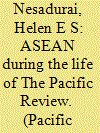

|
|
|
|
|
| Summary/Abstract |
Recent studies of ASEAN have focused on why ASEAN community building has emphasised liberal norms such as human rights, democracy promotion and a commitment to wider participation while maintaining a set of sovereignty-preserving regional principles – the ASEAN Way norms – that have been more suited to securing illiberal agendas and the authoritarian practices of state elites. ASEAN's seeming progressive turn is argued to be instrumentally aimed at buttressing the legitimacy of the grouping as a credible regional institution in international society in which these norms are widely accepted though not uncontested. With recent developments suggesting further consolidation of, or a return to, authoritarian tendencies across the region, state-based modes of governance may become more limited in terms of what ASEAN member states are prepared to endorse. It is, therefore, time for scholars to expand analysis to explore how transnational issues and problems may be functionally governed outside of formal regional institutions involving non-state actors in key roles. While the turn to privately generated standards, rules and practices in global governance is well-recognised and researched, the disparate studies on private governance in South-East Asia are rarely cumulated into a more coherent research programme that addresses the effectiveness of private governance as well as its normative implications. These questions point to a promising agenda for research on regional and other transnational modes of governance in South-East Asia.
|
|
|
|
|
|
|
|
|
|
|
|
|
|
|
|
| 2 |
ID:
101999
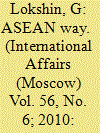

|
|
|
|
|
| Publication |
2010.
|
| Summary/Abstract |
THE PUBLICATION of the book "Bol'shya Vostochnaya Aziya": Mirovaya politika i regional'nye transformatsii. Nauchno-obravovate'nyi kompleks ("Greater East Asia": International Politics and Regional Transformations. Research and Education Handbook. Ed. by A.D. Voskresensky. Moscow, Moscow State Institute (University) of International Relations, 2010, 444 pages) on Greater East Asia (GEA) and the numerous changes taking place in this macroregion is a notable event in Russian political science. The professors and lecturers at the Moscow State Institute (University) of International Relations of the Ministry of Foreign Affairs of the Russian Federation that participated in this collective work called it a "research and education handbook." The book therefore aims to combine strict academic approaches and criteria with new ideas and readability. One should say at once that the book has largely attained its goal - so much so that not just students and experts will find it interesting to read.
|
|
|
|
|
|
|
|
|
|
|
|
|
|
|
|
| 3 |
ID:
158635
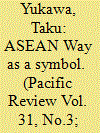

|
|
|
|
|
| Summary/Abstract |
Has the ‘ASEAN Way’ – a set of rules of the Association of Southeast Asian Nations (ASEAN) centered on the principle of non-interference and consensus decision-making – really established its position as an ASEAN norm? This paper aims to analyze the discourses of each ASEAN country and empirically explain their attitudes toward the norm. Specifically, I review various documentations to examine how various ASEAN diplomats have used the term ‘ASEAN Way.’ How did they come to call the principle of non-interference and consensus decision-making ‘ASEAN Way’ in the early 1990s? Why have they begun using the term negatively, as something to be reformed, in recent years? By describing the discourses on the ‘ASEAN Way’ and their changes over the years, I show that the rationality of non-interference and consensus decision-making has changed over time and shifted the positioning of the ‘ASEAN way’ as a symbol. This presents a new and empirical interpretation of the changes in ASEAN Norms.
|
|
|
|
|
|
|
|
|
|
|
|
|
|
|
|
| 4 |
ID:
173188
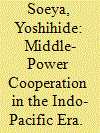

|
|
|
|
|
| Summary/Abstract |
In an Indo-Pacific era characterized by a strategic clash between the US-led Indo-Pacific strategy and the Chinese Belt and Road Initiative, middle-power cooperation needs to be re-conceptualized. Traditional ASEAN-centered processes and institutions may be strengthened if not replaced by a new type of middle-power cooperation involving “external countries” to ASEAN such as Japan, Australia, India, and South Korea.
|
|
|
|
|
|
|
|
|
|
|
|
|
|
|
|
| 5 |
ID:
113840
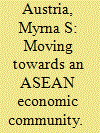

|
|
|
|
|
| Publication |
2012.
|
| Summary/Abstract |
Why are the ASEAN economies increasingly becoming anxious about regional integration? To stay competitive is an obvious answer. Greater cohesion is also imperative for ASEAN to sustain its credibility of being able to provide the platform for interactions in East Asia and the rest of the world. Yet what is offered by the ASEAN Free Trade Area, the ASEAN Framework Agreement on Services, and the ASEAN Investment Area may not be adequate or comprehensive enough for the Association to amass the economic clout commensurate with its position as a pivotal player in East Asia. The ASEAN Economic Community is thus the logical, but not automatic, extension of these regional efforts. Can it come to fruition? This paper discusses how the ASEAN economies may address key issues that have hampered deeper economic integration in the region.
|
|
|
|
|
|
|
|
|
|
|
|
|
|
|
|
| 6 |
ID:
104115
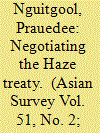

|
|
|
|
|
| Publication |
2011.
|
| Summary/Abstract |
This article examines ASEAN's cooperation on trans boundary haze pollution. I argue that ASEAN's creation of the haze treaty in 2002 demonstrates its attempt to depart from certain elements of eh institutional culture. But both ASEAN's treaty and cooperation have been hindered by certain normative constraints, organizational customs and domestic politics.
|
|
|
|
|
|
|
|
|
|
|
|
|
|
|
|
| 7 |
ID:
114814
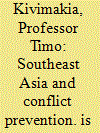

|
|
|
|
|
| Publication |
2012.
|
| Summary/Abstract |
If the assessment of ASEAN's success in the past is difficult, speculations on whether ASEAN will be a success will be close to impossibility. Yet this is what is intended in this article. However, this is done by first defining robust criteria of success of conflict prevention. Conflict prevention is successful if conflicts and battle deaths can be avoided, either by means of conflict resolution or transformation, or simply by means of conflict avoidance. By starting with this criterion the article will argue that ASEAN peacefulness cannot be explained by durable objective conditions. Instead, it is built on imagined realities. The imagined realities of the ASEAN Way are getting more difficult to sustain due to their interaction with material and normative/institutional developments. Many of the constructed foundations of the ASEAN Way are unsustainable in the new realities where communication has become easy and uncontrollable, and societies have become wealthier and more democratized. However, the article will show that evidence of existing conflict violence suggests that ASEAN has started to reformulate its approach to conflict prevention and that this has largely been successful.
|
|
|
|
|
|
|
|
|
|
|
|
|
|
|
|
| 8 |
ID:
113842
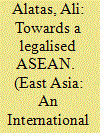

|
|
|
| 9 |
ID:
168497


|
|
|
|
|
| Summary/Abstract |
This article uses the reflection on the direction (whither) and health (wither) of constructivism and the Association of Southeast Asian Nations (ASEAN) that was witnessed in 2017 to see what these deliberations reveal about the fixity of norms and their contestation. The argument presented is that constitutive norms create fixed parameters of shared understandings but that within those parameters the meaning and application of the norm can be contested and debated. This insight helps to bridge the gap between conventional and critical constructivists and shows that the premise of jettisoning the ASEAN Way as necessary for ASEAN to achieve its ambitious community-building project is flawed. The argument relies on insights from the constructivist literature on norm degeneration to show how contestation is not one part of a norm’s life cycle but rather a constant companion. However, norms are not just contested, but they have fixity, and here practice theory can help show that the social world is just as much about continuity as it is change. The ASEAN case study is timely as introspection about the efficacy of its constitutive norms – the ASEAN Way – was prominent in 2017 as ASEAN turned 50.
|
|
|
|
|
|
|
|
|
|
|
|
|
|
|
|